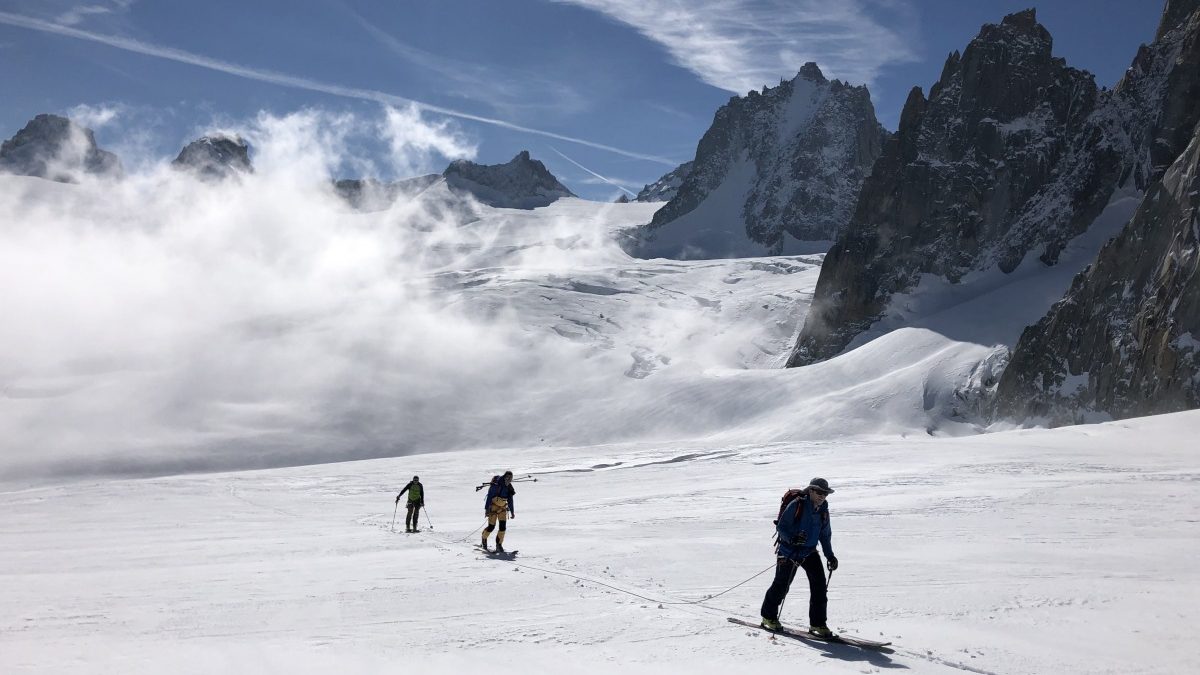Testing the Rap Line Protect Rope
I admit it. I’m a weight-obsessed tech weenie. I think I probably speak for all of us when I imagine our best days touring in the backcountry share some similarities — blue skies, deep pow, an elegant uptrack, and good friends. Missing from that list is a backpack exploding at the seams with gear or worse, one with most of our kit strapped, lashed, and clipped to the outside.
In our communal quest to ski longer and farther, and do it happily, we’re usually chasing lighter weight, or lower mass, as a wise Colorado skier prefers to say. And nowhere does mass and bulk glare more obviously than ropes. Need to do a rappel or tie together on a glacier and suddenly the largest, messiest, bulkiest thing in our arsenal needs to come along. A rope!
I started this piece intending to review Edelrid’s new “Rap Line Protect,” which got me to thinking about skiers, ropes, why, how, and which one on which day. Before we dive into the Edelrid cord, let’s talk about ski ropes in general.
Ropes and skiing — a brief evolution
Some of us get through our whole ski career without ever using a rope. They’re big, heavy, and often tangly — you rope-less skiers might be on to something. Over the last couple decades, though, ski ropes have become skinnier and lighter and now we almost have too many options.
You see fewer and fewer skiers using dynamic climbing ropes these days — not that you can’t get away with using one. They’re simply heavier and thicker (let’s say 7.5mm and fatter) than most of us want when we have skis on our feet.
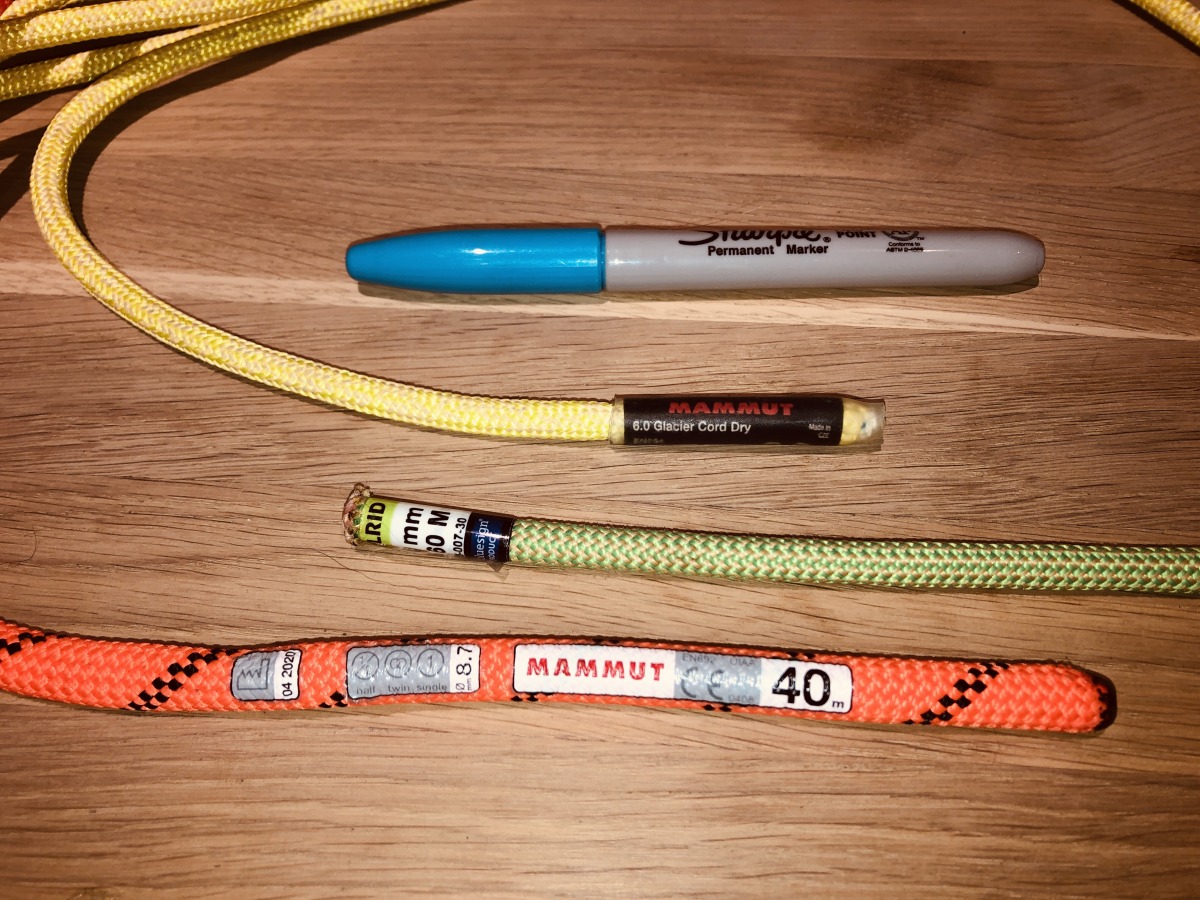
Bottom: Mammut “Alpine Sender” 8.7mm
Middle: Edelrid RLP
Top: Mammut Glacier Cord Dry 6mm
Toptop: Ye olde Sharpie!
Art direction, lighting, and table provided by Coppolillo Worldwide Media
The latest generation of “super-skinny” cords, around 5.5 to 6mm, boast different strengths and shortcomings. Strengths include lighter weight and less bulk, while shortcomings are fiddly handling (when rappelling and hauling), far less cut-resistance, and no dynamic capacity like a climbing rope (which limits a team’s ability to lead a pitch of ice or rock on it).
Edelrid’s Rap Line Protect
Legendary Germany rope manufacturer Edelrid has taken a very specific approach to these niche, super-skinny ropes. Their “Rap Line” cords were originally used as “pull cords,” that is to pull down a rappel rope — usually in rock or alpine climbing. Climbers would tie a super-skinny cord to their fatter, heavier, dynamic climbing rope, thereby doubling the length of a rappel. The first pull cords like these weren’t dry-treated (or coated/treated to resist absorbing water), but some skiers took to using them anyway, favoring their light weight and compact size.
Over the past decade, Edelrid has gradually improved its Rap Line and its latest iteration, the “Rap Line Protect” (or RLP, as I’ll refer to it here; $240 for a 60m; 29g/m advertised, though my home scale measured it at 31g/m) is the company’s latest effort at making a versatile skinny cord which addresses three main shortcomings of these niche ropes — namely, water-resistance, cut resistance, and dynamic capacity.
Water resistance
First, the RLP uses the same dry treatment as Edelrid’s “Pro” ropes, and employs the braided construction of their traditional climbing ropes. This gives the RLP similar “feel” to Edelrid’s German-made climbing cords and equivalent water resistance.
Cut resistance
To address the second shortcoming, cut resistance, Edelrid adds aramid (most of us know aramid by one of its brand names, Kevlar or Nomex are the most common) to the sheath of the 6mm RLP. Through years of R&D and testing, Edelrid developed a means to incorporate aramid to the sheath yarns in the RLP, which roughly doubles the cut-resistance of the rope.
I asked Edelrid’s Product Manager, Philippe Westenberger, 36, about this revolutionary innovation.
“In 2015, during a Swiss mountain-guide training,” he told me, “two candidates were lowered with an 8.7mm rope over an edge. The rope failed (Ed: cut) and luckily both candidates lived.”
After this accident, Westenberger and his Edelrid colleagues began researching rope failures. According to data from the German Alpine Club and the American Alpine Journal, an average of two climbers per year, worldwide, die of severed ropes.
“We researched these rope failures and this (lack of) cut resistance, this is the major reason for rope failures today,” says Westenberger.
Dynamic capacity
The third major improvement Edelrid has achieved with the RLP is dynamic capacity. The RLP’s aramid-reinforced sheath acts static until it’s severely loaded (think: climbing fall). At that point the static aramid material fails, leaving the 6mm nylon/polyamide rope to stretch and dissipate energy, as a traditional climbing rope does. For a short section of belayed climbing, you can fold the RLP in half, tie into the middle, and lead on it as a “twin” rope, clipping both strands through each protection point. The RLP is the only super-skinny with this capability.
When might you use this?
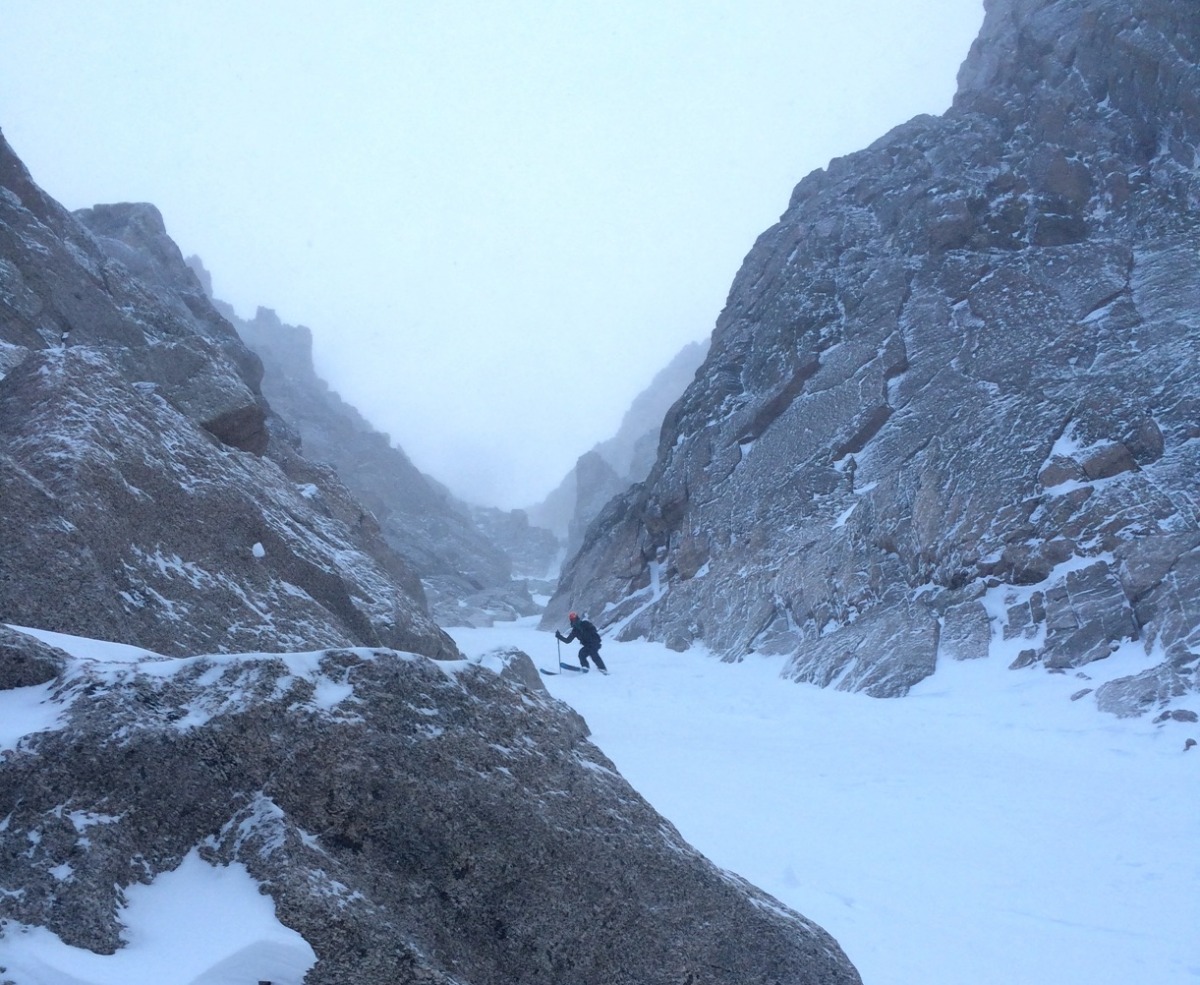
The “Flying Dutchman” couloir in Rocky Mountain National Park. Just above the skier is a short crux of ice (or mixed) climbing that requires just a few “real” climbing moves – the RLP is a perfect rope for a mission like this.
Imagine an objective like Rocky Mountain National Park’s “Flying Dutchman.” It’s an ambitious ski, with a beautiful, steep, snaking couloir at nearly 13,000 feet. It’s an all-day mission, hiking and skinning almost 7 miles to the couloir, then snow climbing several hundred feet, with only 40 or 50 feet of steep, belayed climbing near the top. Why lug a full climbing rope all this way for just a few feet of climbing? With the RLP, you can safely lead on it as a twin, then rappel over this same section on the down — and avoid carrying a heavier, regular climbing rope during the day. Free fitness!
The RLP vs. the Competition
So that’s a bunch of techy details on the RLP. It’s a skinny cord, right, how different can it be?
I’d say overall, what sets the RLP apart is its versatility and cut-resistance. Unlike its competition, you can use the RLP as a glacier travel and rescue rope, for rappelling or lowering, and even leading short sections of steep terrain. Short of buying a rope for each specific application, a versatile cord like the RLP makes a lot of sense for most of us. And of course, the cut resistance seems absolutely revolutionary in terms of rope technology and safety, especially when using it in a shallower snowpack/rockier environment like Colorado of the Alps.
I own another super-skinny, Mammut’s “Glacier Cord” (6mm, $250 for a 60m version; 27g/m home verified, slightly heavier than its advertised 25g/m) and if all I’m doing is carrying it in case of a crevasse fall, I love it. That’d be mid-winter, deeper snow, non-techy objective on the day. Beyond that, it’s a fairly limited tool — that’s not a negative; it was designed as just this, a niche tool.
Petzl’s RAD Line (6mm, $450 for a 60m version; 22g/m claimed weight) is another fantastic choice for a rescue/rap rope, but carries the same limitations as the Mammut, and an additional $200 price penalty for some reason. Ouch! Sterling offers its superlight VT-X (5.4mm, $168 for a 50m version; 21g/m), as well, but it has no dry treatment and a polyester sheath over a Dyneema core. While Dyneema resists water pretty well, polyester is a wicking material and will absorb a bit. And now you’re using an even thinner cord, without the cut resistance of the RLP. Fine on some days, spooky on others. Neither the Mammut, nor the Petzl skinny offers the cut resistance of the RLP, either.
Skiing with the RLP
Unfortunately, lockdown 2.0 here in France didn’t allow quite as much skiing as I had hoped (ack!), but I did get out several days with my older Rap Line II, as well as my newer, RLP. The RLP exhibited the same water repellency as a Mammut or Edelrid alpine rope, no problems at all.
I also left the rope out on a pile of snow on a warm day, letting it sit it in near-slush. After six hours of this it felt damp to the touch, but a half-hour indoors it had dried and it was obvious the moisture was superficial and hadn’t penetrated the sheath.
When traveling on a glacier, roping up with a 6mm rope reduces drag in the snow, compared to a fatter rope. It’s noticeable, too, so during a long traverse, you don’t have the sense of hauling a fuzzy, waterlogged climbing cord. Phew.
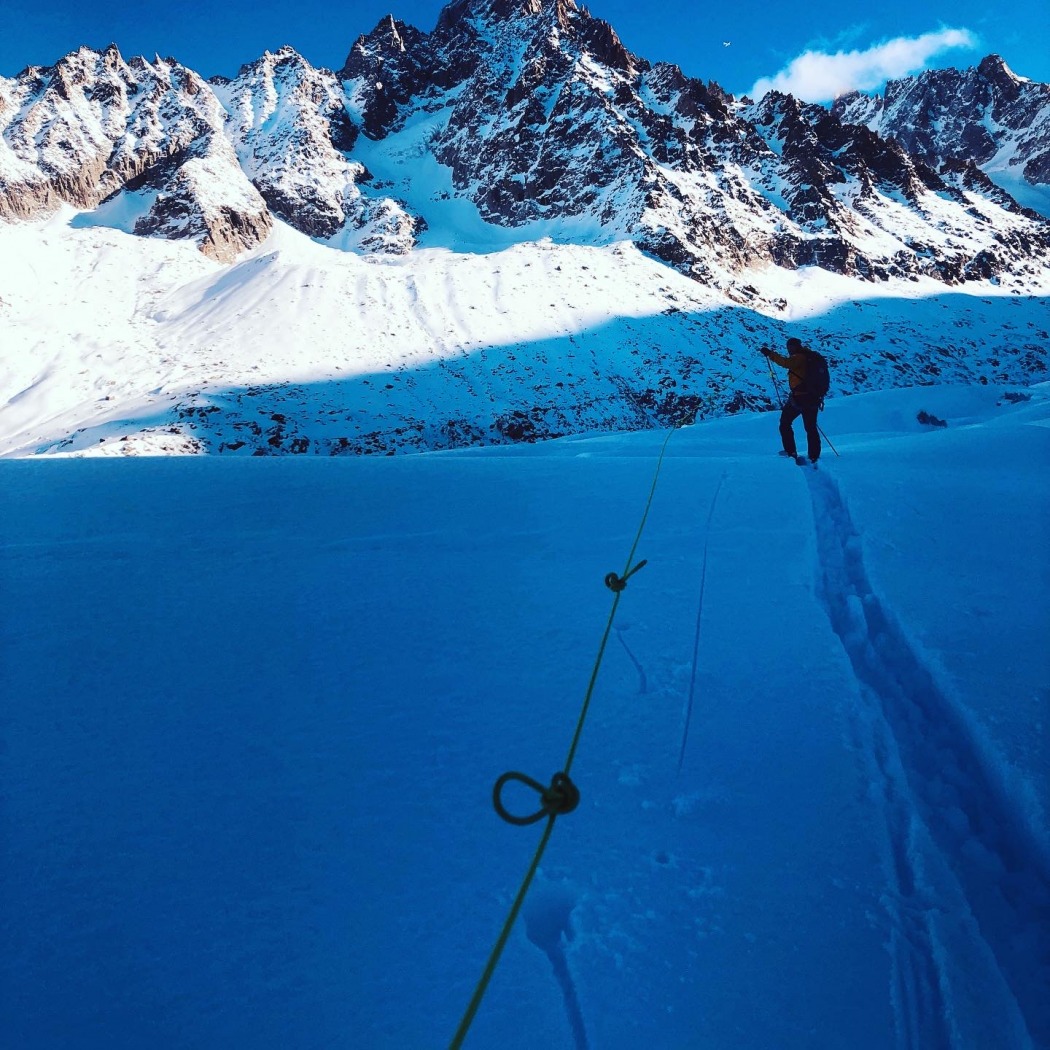
A fatter, bulkier knot offers a better chance of arresting a crevasse fall. Testing these in the RLP on the Argentière Glacier — luckily no falls recorded!
One consideration with a super-skinny is braking knots. A team of two usually ties knots, starting a couple meters away from them, into the rope, to arrest a crevasse fall. These little knots are surprisingly effective in softer snow, but a 6mm rope doesn’t offer much mass to wedge in the snow. Most practitioners tie a larger knot (a rethreaded overhand-on-a-bight works) if using a thinner cord.
Rappelling with the RLP
Aggressive skimo fanatics need a reliable rap cord that’s light and packable, but below 7mm controlling a steep rappel becomes an issue. I tested a variety of rappel devices with the RLP, including a Black Diamond ATC-Guide; ATC-Alpine Guide; Edelrid’s MegaJul, MicroJul, and Mago 8; and an older Petzl Reverso. (Grivel makes an interesting device, “The Scream,” which is specifically designed for smaller-diameter ropes, but I couldn’t obtain one by press time.)
Of these, the only device (apart from the Scream) actually rated for use with a 6mm rope is Edelrid’s “Mago 8” (38g; home verified) a smaller, newer redesign of those original “figure 8” you might have learned to climb with — if you’re old and broken down, like me!
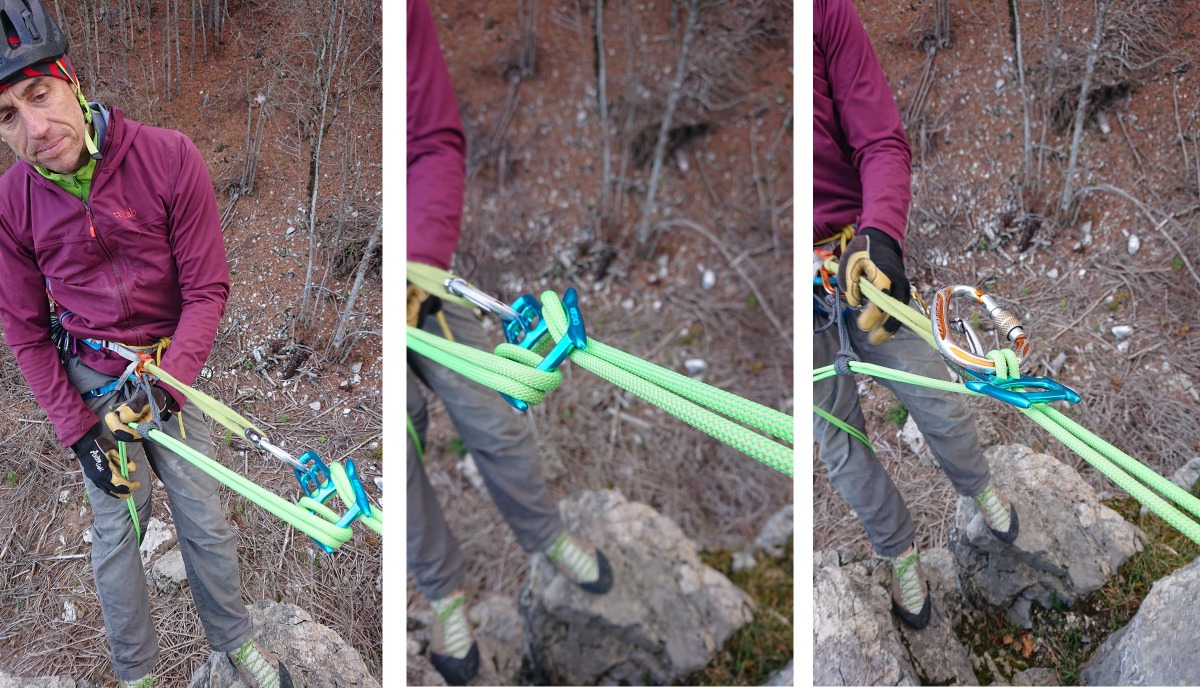
Left and center: The Mago 8 offers plenty of friction when lowering or rappelling in “figure 8” mode and using the extra “horns.”
Right: Rappelling through the two vertical slots on the Mago 8 offer enough friction, but less twisting.
The Mago 8 features a compact 8 design, but with little braking horns on the corners to add friction if you so choose. This worked fine when rappelling (or lowering a climber), but I greatly preferred the two channels on the back of the device (see photo) for rappelling. Figure 8’s, like an Italian/Munter hitch, tend to twist the rope and the Mago’s back channels offered smooth, high-friction rappelling.
The next best device was the MicroJul, Edelrid’s assisted-braking device designed for twin/half ropes down to 6.9mm. Rappelling with the Micro, in both its assisted and unassisted modes, was smooth, controllable, and easy, though a bit less friction than the Mago 8.
“We originally developed the Mago 8 for ski-mountaineering,” explains Westenberger. “When you have to lower someone, it is nice because to use an HMS*, it abraids the rope much faster and it can get twists.”
(*Ed: An HMS — or halbmastwurfsicherung in German — carabiner is a locking carabiner large enough to use with a “Munter” or “Italian” hitch.)
When I told him I’d used the MicroJul for rappelling and lowering, despite not being rated down to 6mm, he said, “That is OK, we recommend people to use two HMS carabiners.” This adds significant friction, so if rappelling with a pack, or if you’re more than 175 lbs. or so, keep this solution in mind.
Larger devices like an ATC-Guide and Reverso aren’t rated for use with cords this skinny and it was obvious why — very little friction. Adding an HMS carabiner helps, but if you’re dorked-out enough to buy an RLP, or any of these specialized ropes, just buy a MicroJul — way more predictable and safer than a full-sized device. The Micro weighs 62g and is made of stainless steel — I have a MegaJul that’s 8 years old and doesn’t have a lick of wear on it. Worth it!
If you do, however, find yourself rappelling with a larger device like an ATC-Guide, a trick: feed both strands of the rappel rope through one of the channels on the ATC, rather than both. Is this recommended or approved? No, but plenty of people do it. I’ve rappelled several pitches like this and found it predictable. Proceed with caution.
And one last thought when rapp’ing with a super-skinny: if tying a 6mm rope to a larger, dynamic climbing rope, a flat overhand is fine. Edelrid, among many others, have tested it and it works. Long tails, clean knot, tighten each strand individually, 18-inch tails – perfect!
Hauling with the RLP
If using any of these skinny cords for hauling, practice ahead of time with a variety of devices. The RLP has been tested with Edelrid’s Spoc device and works just fine. Experiment with your preferred hauling/rescue kit to make sure you can effect a rescue or haul a pack, before it’s dark, wet, and you’re under the gun!
Climbing with the RLP
Leading on the Rap Line Protect is actually pretty cool. Because it is so skinny and light, even doubled as a twin rope, there is almost no friction and you feel like you’re soloing. I used an earlier version of the RLP to lead a pitch in Las Vegas, when my climbing rope was stuck on a rappel. Worked great but boy, it looks like a couple of shoelaces once you’re 20 feet above your last piece! I also led an easy pitch of rock this fall with my new RLP — great handling, super light, kinda spoils you for going back to a fatter, dynamic climbing rope!
The Mago 8 guide-style belays the RLP through the back channels I mentioned above. Probably not going to get much use out of it that way, but it’s a nice feature. High friction and reliable, as far as my limited experience shows.
Again, the RLP is not first and foremost a climbing rope, but it is the only super-skinny that offers the performance of a dynamic rope, if you need it.
Conclusions
If you’re going to buy one skinny cord for year-round use on rock, snow, and in the alpine, the RLP is the most versatile one out there. If, like skis, backpacks, boots, and so many other things you’re going to build a quiver, then you might own an even lighter and smaller option and the RLP. Yes, your children’s inheritance takes another hit and your non-skiing significant other will find this absurd. Throw me under the bus; happy to take the hit for you.
Edelrid still makes all of its ropes in Germany and they’re all bluesign rated, meaning they’re produced using less energy and fewer raw materials when possible. Nice detail to know when considering options. I’ve been using Edelrid cords for nearly a decade and found them to be exacting, precisely made, and durable. The RLP is a recommended buy, if you’re looking for a super-skinny ski rope.
Rob Coppolillo lives, guides, and writes from his home base in Chamonix, France. His latest book, The Ski Guide Manual, is available for purchase here.
Rob Coppolillo is a mountain guide and writer, based on Vashon Island, in Puget Sound. He’s the author of The Ski Guide Manual.

